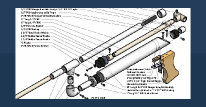
Air Gun Tables For Design And Testing
#26

Posted 13 August 2010 - 02:34 AM
#27

Posted 13 August 2010 - 09:01 PM
But we are trying to find the perfect barrel length to find the furthest distance our type of darts can go?
Go read the first post; I tried to make clear some potential uses for this table.
Doom this information is absolutely fantastic and exactly what I was looking for. You saved me a lot of trouble as before I found this thread I was trying to calculate all this myself and I was having trouble figuring out what drag coefficient to use for slug darts. Also very much appreciate the range equations. I would be very interested in seeing a Springer spreadsheet as I primarily work with Springers. Thanks again keep up the good work.
I'm glad you like the table and equations.
I'll work on the springer table after I refine the air gun one and fully document the derivation for others.
I did post an ideal barrel length equation for springers somewhere in here. This equation should apply for situations similar to when the air gun one applies.
If you have any other suggestions or requests, I'd like to hear them.
#28

Posted 14 August 2010 - 12:48 AM
A second restricting assumption made is that the plunger hits the end of the plunger tube when the projectile leaves.
Wouldn't it be relatively simple to determine the amount of time it takes for your plunger to reach the end of the chamber? Hell, you could use a microphone and Audacity and find the distance between the peeks in the waveform, from the click of the catch to the slam of the plunger. Light gates or limit switches are easy enough to set up though, if you have some kind of accurate timing device to connect them to. I imagine you would have to fire the gun with a loaded barrel to get an accurate reading. My guess is that for taking such measurements, the length of the barrel wouldn't have much impact on the time from "click" to "slam". Once the static friction of the dart is overcome, the difference in time to fire the gun is probably negligible for different barrel lengths. The fit of different darts from the same batch in the same barrel probably causes more deviation.
The theory is a bit above my head, so not sure if timing the gun would help much.
Also, why is it always assumed that there is no dead space? Is it possible to factor in dead space? The volume of dead space is so easy to measure, and it's so common in nerf guns that I'd think it would be more accurate to assume 10 or 15mL than 0.
You can poop in my toilet anytime champ.
2016 Nerf War Schedule
Bless you, my son. Now recite 3 New Members Guides and 5 Code of Conducts for your sins.
#29

Posted 14 August 2010 - 08:30 AM
Wouldn't it be relatively simple to determine the amount of time it takes for your plunger to reach the end of the chamber?
Determining that time should be fairly simple. You suggest a number of different ways to approach this that all sound reasonable. There's another possibility worth considering too. A guy at SpudFiles uses magnetic projectiles and spaced coils to track projectiles down the barrel. Something similar with the plunger could be made.
My guess is that for taking such measurements, the length of the barrel wouldn't have much impact on the time from "click" to "slam". Once the static friction of the dart is overcome, the difference in time to fire the gun is probably negligible for different barrel lengths. The fit of different darts from the same batch in the same barrel probably causes more deviation.
This sounds plausible.
There's another thing to consider too. The flow velocity maxes out ("chokes") when the ratio of pressures in the barrel to spring chamber goes below a certain critical value. So at that point, what happens in the barrel doesn't really matter as long as the pressure doesn't increase to be over that ratio.
Of course, if the connection between the barrel and the spring chamber doesn't impede the flow at all so that the pressures are approximately equal, then this won't happen. The speed of sound of the gas might do something similar, but I'm not certain; my current simulations don't take that into account.
Also, why is it always assumed that there is no dead space? Is it possible to factor in dead space? The volume of dead space is so easy to measure, and it's so common in nerf guns that I'd think it would be more accurate to assume 10 or 15mL than 0.
The assumption is that the dead space is 0.1% of the volume of the barrel, not that there is none. Dead space is actually required for the simulation. If there was no dead space, the barrel chamber wouldn't have any volume for the first few time steps, but there will be flow into it; consequently the pressure will be infinite. This doesn't make physical sense. Dead space is consequently necessary for the simulation as I've written it.
From some of the other simulations I've run, dead space actually has essentially no effect on performance up until it's about 10% of the volume of the barrel. This surprised me. What this means is that the assumption that there is little dead space seems to be reasonable.
For the tests I did, the dead space was 21% of the volume of the barrel. This volume was very easy to quantify with some water and a small measuring cup.
0 user(s) are reading this topic
0 members, 0 guests, 0 anonymous users











